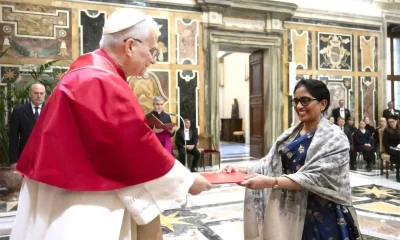News
Tilake Abeysinghe passes away

Internationally reputed painter and sculptor Tilake Abeysinghe passed away in Toronto, Canada, last week. Abeysinghe was a graduate of the Accademia di Belle Arti di Brera in Milan, where he studied painting under Domenico Cantatore and came under the influence of the world-renowned sculptor Mario Marini.
After graduation from the academy, he held exhibitions at art centres in Italy and Switzerland and established his own Atelier in Milan in 1980. In a professional career, spanning over 70 years, he held over 75 one-man exhibitions and represented Sri Lanka in several International Exhibitions. His work was exhibited in Colombo, Toronto, Sao Paulo, Montreal, New Delhi, Dhaka, Fukuoka, Karachi, Paris, Beijing, Copenhagen, Hamburg and London.
His major works include a 25-foot-high sculpture at the Italian Embassy, in Colombo, an 85-foot mural spanning the entire breadth of the Standard Chartered Bank building, in Colombo, a large mural in bas-relief at the American Express Bank, in Colombo, a 10-foot-tall bronze statue of Capt. C.P.J. Seneratne, at Girandurukotte, a bust of Sri Jawaharlal Nehru at the Indian High Commission, in Colombo, and several large paintings, portraits and a 12-foot sculptured monument for the Central Bank of Sri Lanka, in Colombo.
Abeysinghe was awarded several accolades during his long career. Among them are the first prize for designing the Buddhajayanthi Stamp (1955), the Gold award for the most outstanding personality for aesthetic art by Lions International (1984), the Gold award at the Japan-Sri Lanka Exhibition in 1993, the Kalapathi award of Sri Lanka Society of Arts (1993), Vishva Prasadini and Ruhunuputhra Awards (1993). In 1984 he was invested with the singular title of “Cavaliere of the Order of Merit ” (knighthood) by the Italian Government for his services to art and sculpture.Tilake donated millions of Rupees to Sri Lanka to battle COVID-19. This includes ventilators, oxygen regulators, oxygen, blood gas analysis cartridges, ICU equipment, endotracheal tubes, and urgent ICU medicine. Proceeds of Tilake’s final exhibition in Toronto went to support malnourished families including pregnant mothers, lactating mothers and children less than five years old.
The font of Tilake’s Art is found in the lush green fields and forest glades of the Village of Karatota in the deep South where he was born. The salient features of his art are simplicity and economy. Simplicity in form and economy of means used to bring a canvas to life are derived from the unwritten philosophy of the Sri Lankan Villager, rooted as it is in the Teaching of the Buddha. Tilake’s myriad canvases are a celebration of life itself, an “Ode to Joy” in a Sri Lankan manner.
His paintings are permeated with beings of ethereal beauty, more often than not in the feminine incarnation. These canvases, which shout for the sheer joy of living, have oftentimes been created despite dire personal tragedy, like Schubert’s music. However, there is no trace of anguish in them. Tilake’s paintings are also highly original, they bear no stamp of allegiance to any other artist. Tilake’s paintings are simple and direct and they do need no titles either. Tilake paints from an inner compulsion to create and calls his paintings his “other children”. His legacy will remain for generations to come.
News
Financial contributions received for ‘Rebuilding Sri Lanka’ Fund

The Government’s ‘Rebuilding Sri Lanka’ Fund, established to provide relief and support to communities affected by Cyclone Ditwah, continues to receive financial contributions on a daily basis.
Accordingly, the Containers Transport Owners Association made a financial contribution of Rs. 1.5 million, while the Association of SriLankan Airlines Licensed Aircraft Engineers contributed Rs. 1.35 million to the Fund.
The respective cheques were formally presented to the Secretary to the President, Dr. Nandika Sanath Kumanayake, at the Presidential Secretariat on Friday (19).
The occasion was attended by W. M. S. K. Manjula, Chairman of the Containers Transport Owners Association, together with Dilip Nihal Anslem Perera and Jayantha Karunadhipathi.
Representing the Association of SriLankan Airlines Licensed Aircraft Engineers were Deshan Rajapaksa, Samudika Perera and Devshan Rodrigo handed over the cheque.
News
UNICEF representatives and PM discuss rebuilding schools affected by the Disaster

A meeting between Prime Minister Dr. Harini Amarasuriya and a delegation of UNICEF representatives was held on Saturday, (December 20) at the Prime Minister’s Office.
During the meeting, the Prime Minister explained the measures taken by the Government to ensure the protection of the affected student community and to restore the damaged school system, as well as the challenges encountered in this process.
The Prime Minister stated that reopening schools located in landslide-prone areas would be extremely dangerous. Accordingly, the Government is focusing on identifying such schools and relocating them to suitable locations based on scientific assessments.
The Prime Minister further noted that financial assistance has been provided to students affected by the disaster, enabling parents to send their children back to school without an additional financial burden. Emphasizing that school is the safest place for children after their homes, the Prime Minister expressed confidence that the school environment would help restore and improve students’ mental well-being
The Prime Minister also highlighted that attention has been given to several key areas, including the relocation of disaster-affected schools, restoration of school infrastructure, merging and operating certain schools jointly, facilitating teaching and learning through digital and technological strategies, and providing special transportation facilities. She emphasized that the Government is examining these issues and is committed to finding long-term solutions.
The UNICEF representatives commended the Government’s commitment and the initiatives undertaken to restore the education sector and assured their support to the Government. Both parties also discussed working together collaboratively on future initiatives.
The meeting was attended by the UNICEF representatives to Sri Lanka Emma Brigham, Lakshmi Sureshkumar, Nishantha Subash, and Yashinka Jayasinghe, along with Secretary to the Ministry of Education Nalaka Kaluwewa, Director of Education Dakshina Kasturiarachchi, Deputy Directors Kasun Gunarathne and Udara Dikkumbura.
(Prime Minister’s Media Division)
News
NMRA laboratory lacks SLAB accreditation

Drug controversy:
“Setting up state-of-the-art drug testing facility will cost Rs 5 billion”
Activists call for legal action against politicians, bureaucrats
Serious questions have been raised over Sri Lanka’s drug regulatory system following revelations that the National Medicines Regulatory Authority’s (NMRA) quality control laboratory is not accredited by the Sri Lanka Accreditation Board (SLAB), casting doubt on both the reliability of local test results and the adequacy of oversight of imported medicines.
Medical and civil rights groups warn that the issue points to a systemic regulatory failure rather than an isolated lapse, with potential political and financial consequences for the State.
Chairman of the Federation of Medical and Civil Rights Professional Associations, Specialist Dr. Chamal Sanjeewa, said the controversy surrounding the Ondansetron injection, which was later found to be contaminated, had exposed deep weaknesses in drug regulation and quality assurance.
Dr. Sanjeewa said that the manufacturer had confirmed that the drug had been imported into Sri Lanka on four occasions this year, despite later being temporarily withdrawn from use. The drug was manufactured in India in November 2024 and in May and August 2025, and imported to Sri Lanka in February, July and September. On each occasion, 67,600 phials were procured.
Dr. Sanjeewa said the company had informed the NMRA that the drug was tested in Indian laboratories, prior to shipment, and passed all required quality checks. The manufacturer reportedly tested the injections against 10 parameters, including basic quality standards,
pH value, visual appearance, component composition, quantity per phial, sterility levels, presence of other substances, bacterial toxin levels and spectral variations.
According to documents submitted to the NMRA, no bacterial toxins were detected in the original samples, and the reported toxin levels were within European safety limits of less than 9.9 international units per milligram.
Dr. Sanjeewa said the credibility of local regulatory oversight had come under scrutiny, noting that the NMRA’s quality control laboratory was not SLAB-accredited. He said establishing a fully equipped, internationally accredited laboratory would cost nearly Rs. 5 billion.
He warned that the failure to invest in such a facility could have grave consequences, including continued loss of life due to substandard medicines and the inability of the State to recover large sums of public funds paid to pharmaceutical companies for defective drugs.
“If urgent steps are not taken, public money will continue to be lost and accountability will remain elusive,” Dr. Sanjeewa said.
He added that if it was ultimately confirmed that the drug did not contain bacterial toxins at the time it entered Sri Lanka, the fallout would be even more damaging, severely undermining the credibility of the country’s health system and exposing weaknesses in health administration.
Dr. Sanjeewa said public trust in the health sector had already been eroded and called for legal action against all politicians and public officials responsible for regulatory failures linked to the incident.
by Chaminda Silva ✍️
-

 Midweek Review5 days ago
Midweek Review5 days agoHow massive Akuregoda defence complex was built with proceeds from sale of Galle Face land to Shangri-La
-

 News4 days ago
News4 days agoPope fires broadside: ‘The Holy See won’t be a silent bystander to the grave disparities, injustices, and fundamental human rights violations’
-

 News4 days ago
News4 days agoPakistan hands over 200 tonnes of humanitarian aid to Lanka
-

 News5 days ago
News5 days agoBurnt elephant dies after delayed rescue; activists demand arrests
-

 Business3 days ago
Business3 days agoUnlocking Sri Lanka’s hidden wealth: A $2 billion mineral opportunity awaits
-

 Editorial5 days ago
Editorial5 days agoColombo Port facing strategic neglect
-

 News3 days ago
News3 days agoArmy engineers set up new Nayaru emergency bridge
-

 News5 days ago
News5 days agoSri Lanka, Romania discuss illegal recruitment, etc.













